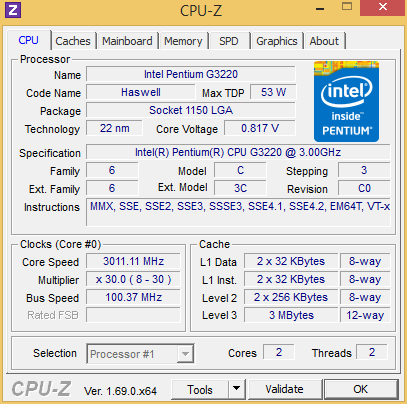Test Methodology
Intel Pentium G3220 Specification |
|---|
 |
Comparison Processor Configurations |
||||||||||
|---|---|---|---|---|---|---|---|---|---|---|
| CPU | Intel |
AMD | ||||||||
Core i5-4210Y |
Core i5-4250U |
Pentium G3220 |
Core i3-4330 |
Core i5-4670 |
Athlon 5350 |
A8-7600K |
A10-7850K |
A8-6500T |
A10-6800K |
|
| CPU TDP | 11.5W |
15W |
53W |
54W |
84W |
25W |
65W/45W |
95W |
65W |
100W |
| Socket | BGA 1168 |
BGA 1168 |
LGA 1150 |
LGA 1150 |
LGA 1150 |
AM1 |
FM2+ |
FM2+ |
FM2 |
FM2 |
| Fabrication | 22nm |
22nm |
22nm |
22nm |
22nm |
28nm |
28nm |
28nm |
32nm |
32nm |
| Motherboard | Sony Vaio Haswell ULT |
Intel NUC Reference |
Gigabyte GA-Z87M-D3H |
Gigabyte GA-Z87-D3HP |
ASRock AM1B-ITX+ |
ASRock FM2A88X-ITX+ |
||||
| BIOS | R0290V8 |
2135 |
F9 |
F5 |
1.0 |
1.90 |
||||
| DDR3 Memory | 4GB (1x4GB) |
8GB (2x4GB) |
Corsair XMS3 4GB (1x4GB) / 8GB (2x4GB) |
AMD Gamer Series 16GB (2x8GB) |
AMD Gamer Series 4GB (1x4GB) |
AMD Gamer Series 16GB (2x8GB) |
||||
| Memory Timings | 11-11-11-28-1T @ 1,600MHz |
11-11-11-28-1T @ 1,600MHz |
9-9-9-24-2T @ 1,600MHz |
9-10-9-27-2T @ 1,866MHz |
9-9-9-28-2T @ 1,600MHz |
10-11-11-28-2T @ 2,133MHz |
9-10-9-27-2T @ 1,600MHz |
10-11-11-28-2T @ 2,133MHz |
||
| Integrated Graphics | HD 4200 |
HD 5000 |
HD Graphics |
HD 4600 |
HD 4600 |
Radeon R3 |
Radeon R7 |
Radeon R7 |
HD 8550D |
HD 8670D |
| Disk Drive | Toshiba THNSNH128GMCT 128GB |
Plextor PX-128M5M 128GB |
Crucial M500 240GB |
Samsung 840 Pro 250GB |
||||||
| Chassis | Sony Tap 11 |
Intel NUC D54250WYK |
Corsair Graphite 600T |
|||||||
| Power Supply | Sony External (44W) |
Intel External (65W) |
Corsair VS450 (450W) |
Corsair AX760i (760W) |
||||||
| Operating System | Windows 8.1 64-bit |
|||||||||
CPU and Memory Benchmarks |
||||||||||
| HEXUS PiFast | Our number-crunching benchmark stresses a single core by calculating Pi to 10m places | |||||||||
| CineBench R15 | Using Cinebench's multi-CPU render, this cross-platform benchmark stresses all cores | |||||||||
| wPrime 2.1.0 | Another number-crunching benchmark that stresses all available CPU cores/threads | |||||||||
| AIDA64 v4.00.2746 | Benchmark that analyses memory bandwidth and latency | |||||||||
Multimedia Benchmarks |
||||||||||
| LuxMark 2.0 | An OpenCL rendering benchmark | |||||||||
| MuseMage 1.9.6 | An OpenCL image-manipulation benchmark (64-bit) | |||||||||
| HandBrake 0.9.9.1 | Free-to-use video encoder that stresses all CPU cores (64-bit) | |||||||||
System Benchmarks |
||||||||||
| PCMark 8 v2.0 | System-wide examination that uses the Home preset, run with OpenCL acceleration | |||||||||
| 3DMark | DX11, run at the Firestrike default test | |||||||||
| SiSoft Sandra 2014 | Aggregate score that takes a composite of 12 system-wide benchmarks | |||||||||
Gaming Benchmarks |
||||||||||
| BioShock Infinite | DX9, 1,280x720, medium quality | |||||||||
| GRID 2 | DX9, 1,280x720, high quality | |||||||||
| Total War: Rome II | DX9, 1,280x720, medium quality | |||||||||
Miscellaneous Benchmarks |
||||||||||
| Power Consumption | While idling and when running wPrime and GRID 2 | |||||||||
Notes
The head-to-head comparison that we're particularly intrigued by is Intel's Pentium G3220 against AMD's Athlon 5350. Both are aimed at low-cost desktops and carry an identical £42 price tag, so it'll be interesting to see how the two compare.
The Intel part is capable of supporting dual-channel memory, but to provide directly comparable results, we've benchmarked the Pentium platform in two states; firstly with a single 4GB stick of RAM (matching the Athlon build); and secondly with two 4GB sticks of RAM to see if there are substantial benefits to dual-channel memory.









